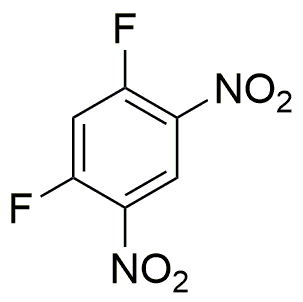1,5-Difluoro-2,4-dinitrobenzene is widely utilized in research focused on:
- Analytical Chemistry: This compound serves as a reagent in the synthesis of various organic compounds, aiding researchers in developing new materials and pharmaceuticals.
- Pharmaceutical Development: It is used in the design of drug candidates, particularly in the study of anti-cancer agents, due to its ability to modify biological activity.
- Environmental Monitoring: The compound helps in the detection and analysis of pollutants, providing valuable data for environmental scientists working on contamination issues.
- Material Science: Its unique properties make it suitable for creating advanced materials, such as polymers with enhanced thermal stability and chemical resistance.
- Research on Fluorinated Compounds: It plays a crucial role in studying the effects of fluorination on chemical reactivity, which is important for developing new industrial applications.
General Information
Properties
Safety and Regulations
Applications
1,5-Difluoro-2,4-dinitrobenzene is widely utilized in research focused on:
- Analytical Chemistry: This compound serves as a reagent in the synthesis of various organic compounds, aiding researchers in developing new materials and pharmaceuticals.
- Pharmaceutical Development: It is used in the design of drug candidates, particularly in the study of anti-cancer agents, due to its ability to modify biological activity.
- Environmental Monitoring: The compound helps in the detection and analysis of pollutants, providing valuable data for environmental scientists working on contamination issues.
- Material Science: Its unique properties make it suitable for creating advanced materials, such as polymers with enhanced thermal stability and chemical resistance.
- Research on Fluorinated Compounds: It plays a crucial role in studying the effects of fluorination on chemical reactivity, which is important for developing new industrial applications.
Documents
Safety Data Sheets (SDS)
The SDS provides comprehensive safety information on handling, storage, and disposal of the product.
Product Specification (PS)
The PS provides a comprehensive breakdown of the product’s properties, including chemical composition, physical state, purity, and storage requirements. It also details acceptable quality ranges and the product's intended applications.
Certificates of Analysis (COA)
Search for Certificates of Analysis (COA) by entering the products Lot Number. Lot and Batch Numbers can be found on a product’s label following the words ‘Lot’ or ‘Batch’.
Numéro de catalogue
Numéro de lot/série
Certificates Of Origin (COO)
This COO confirms the country where the product was manufactured, and also details the materials and components used in it and whether it is derived from natural, synthetic, or other specific sources. This certificate may be required for customs, trade, and regulatory compliance.
Numéro de catalogue
Numéro de lot/série
Safety Data Sheets (SDS)
The SDS provides comprehensive safety information on handling, storage, and disposal of the product.
DownloadProduct Specification (PS)
The PS provides a comprehensive breakdown of the product’s properties, including chemical composition, physical state, purity, and storage requirements. It also details acceptable quality ranges and the product's intended applications.
DownloadCertificates of Analysis (COA)
Search for Certificates of Analysis (COA) by entering the products Lot Number. Lot and Batch Numbers can be found on a product’s label following the words ‘Lot’ or ‘Batch’.
Numéro de catalogue
Numéro de lot/série
Certificates Of Origin (COO)
This COO confirms the country where the product was manufactured, and also details the materials and components used in it and whether it is derived from natural, synthetic, or other specific sources. This certificate may be required for customs, trade, and regulatory compliance.


